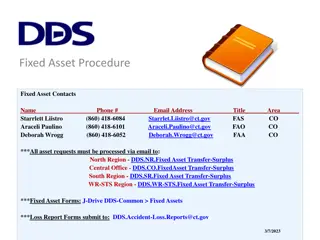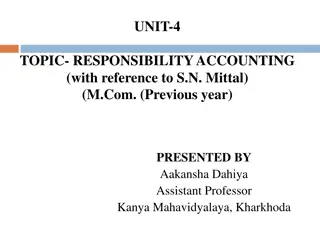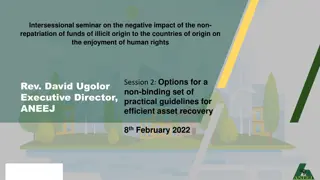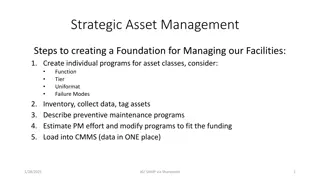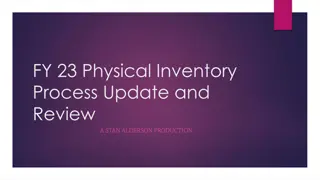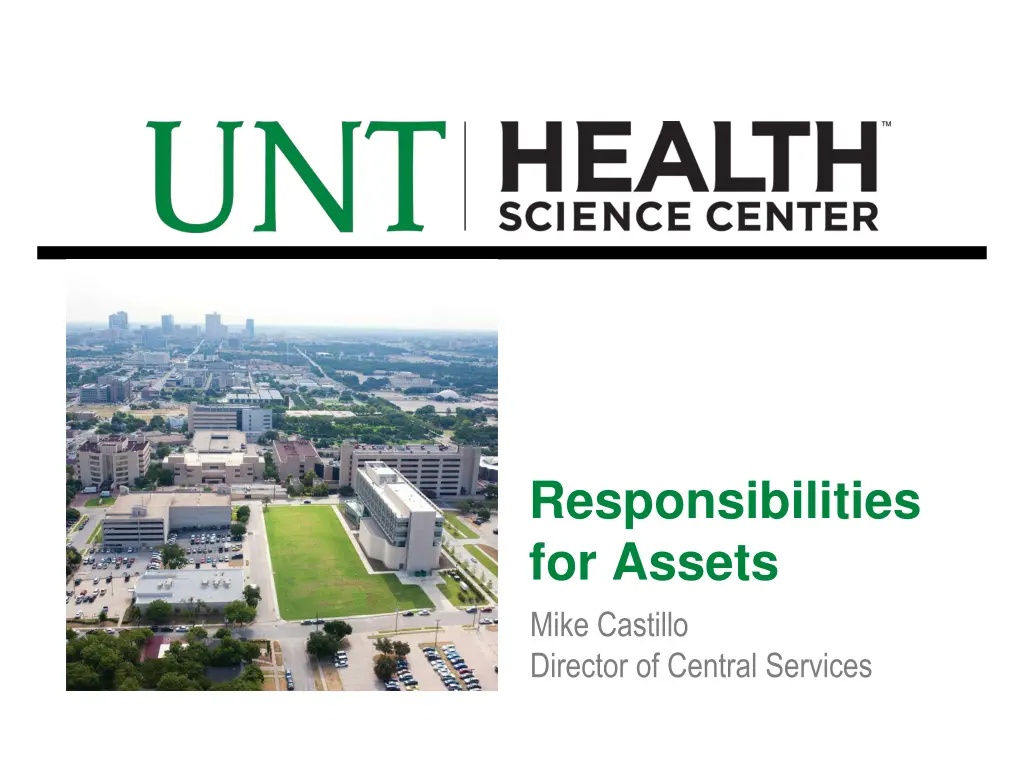
Responsibilities for Assets Management in State Agencies
This comprehensive guide outlines the responsibilities for assets management within state agencies, covering property control personnel, state governing agencies, UNTHSC roles, and state fiscal policies. Responsibilities range from maintaining centralized records to ensuring proper use of state equipment, with specific individuals and offices designated for asset management tasks.
Download Presentation

Please find below an Image/Link to download the presentation.
The content on the website is provided AS IS for your information and personal use only. It may not be sold, licensed, or shared on other websites without obtaining consent from the author. If you encounter any issues during the download, it is possible that the publisher has removed the file from their server.
You are allowed to download the files provided on this website for personal or commercial use, subject to the condition that they are used lawfully. All files are the property of their respective owners.
The content on the website is provided AS IS for your information and personal use only. It may not be sold, licensed, or shared on other websites without obtaining consent from the author.
E N D
Presentation Transcript
Responsibilities for Assets Mike Castillo Director of Central Services
Responsibility for Assets Property Control Personnel Pamela Little - 5151 3420 Darcy St 76107 General Service Building Property Control Office GSB 144 817-735-2152 Property Manager Richard Clemens - 2152 Administrative Assistant Christina Castro - 2152 Surplus GSB 138 817-735-2971 Telephone 817-735-0220 Fax Property Inventory Specialist Bryan Yerg - 2971 Property Support Specialist
Responsibility for Assets State Governing Agencies Comptroller of Public Accounts/State Property Accounting The Comptroller shall administer the property accounting system and maintain centralized records based on information supplied by state agencies. The property accounting system shall constitute, to the extent possible, the fixed asset component of the uniform statewide accounting system. Office of the Attorney General (OAG) The OAG may investigate a report received for negligence or theft. If the investigation reveals that a property loss occurred through the negligence of a state official or employee, the OAG makes a written demand on the official or employee for reimbursement of the loss. If the demand is refused or disregarded, the OAG may take legal action to recover the value of the property, as that office deems necessary. The OAG determines the value to be recovered based on the market value of the property and the degree of responsibility of the person who was entrusted with the property. State Auditor s Office (SAO) The state auditor shall ensure that the accounting and financial reporting procedures of each state agency conform to the procedures. The state auditor, based on a risk assessment and subject to the legislative audit committee's approval of including the examination in the audit plan under Section 321.013, may periodically examine property records or inventory as necessary to determine if controls are adequate to safeguard state property.
Responsibility for Assets UNTHSC President The head of each state agency is responsible for the custody and care of property in the agency's possession. Property Manager The property manager of a state agency shall maintain the records required and be the custodian of all property possessed by the agency. UNTHSC Department Head The head of each UNTHSC department is responsible for the custody and care of property in the department's possession. Asset Coordinator Property Control s point of contact in the department for assets concerning additions, deletions, location changes, accountability changes, cannibalizations and conducting the annual inventory. End User It is each state employee s responsibility to use property only for state purposes and to exercise reasonable care for its safekeeping.
Responsibility for Assets State and Fiscal Policies Use of State Equipment No person shall entrust State property to any State official or employee or to anyone else to be used for other than State purposes. Health Science Center property shall be used only for official business. No employee of the Health Science Center shall use for his own personal benefit or pleasure any property of the Health Science Center except books from the Library and other such items of well established use.
Responsibility for Assets State and Fiscal Policies Appropriation Reductions for Lost Property If an agency or institution reports property loss that exceeds the standards set by the American Society for Testing and Materials (ASTM), then the Comptroller s office must withhold 50 percent of the value of the excess amount from the agency s appropriated general revenue, General Revenue Dedicated, or other funds appropriated to the state agency or institution of higher education. (See GAA, Article IX, 12.04, 79th Leg., R.S.) If an agency or institution subsequently recovers or accounts for the lost property to the satisfaction of the Comptroller s office, the Comptroller s office returns a proportional amount of previously withheld funds. The Fund Accounting Division of the Comptroller s office is responsible for implementing GAA, Article IX, 12.04. Responsibilities of specific sections in Fund Accounting are as follows: The State Property Accounting section maintains the SPA system. The Appropriation Control section reduces and reinstates appropriations. Zero percent for high-risk assets.The Comptroller s office has designated firearms as high-risk. In the future, the Comptroller s office may determine that other types of property meet the definition of high-risk. Two percent of an agency s non-high-risk assets by AFR category. All property except firearms is non-high- risk.
Responsibility for Assets State and Fiscal Policies SECTION XI. Acquisition and Disposal of Surplus, Obsolete, Unserviceable, or Damaged Property. SECTION XII (a) (c). (a) Responsibility. (c) Inventories Equipment. (d) Adjustment of Inventory. (e) Equipment on Loan. (f) Removing State Owned Equipment from Campus. (g) Private Property. (h) Moving Equipment or Furniture. (i) Pecuniary Liability of Health Science Center Employees.







